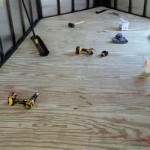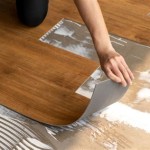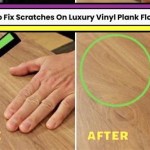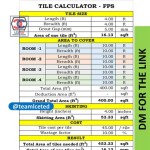Luxury Vinyl Flooring or Engineered Wood: Which is Better for Stairs?
Selecting the appropriate flooring material for stairs involves careful consideration of various factors, including aesthetics, durability, safety, and cost. Luxury Vinyl Flooring (LVF) and Engineered Wood are often considered viable alternatives to traditional hardwood or carpeting due to their respective advantages. This article will examine the comparative benefits and drawbacks of LVF and Engineered Wood for stair applications, enabling informed decision-making.
The unique demands placed on stair flooring necessitate a material that can withstand heavy foot traffic, resist slipping, and maintain its appearance over time. Stairs are high-impact areas, vulnerable to scratches, dents, and wear from regular usage. The choice between LVF and Engineered Wood depends largely on the prioritization of these specific performance characteristics, alongside budgetary constraints and aesthetic preferences.
Understanding the fundamental differences between LVF and Engineered Wood is crucial before delving into their stair-specific suitability. Luxury Vinyl Flooring is a synthetic material composed of multiple layers, including a PVC core, a printed decorative layer, and a protective wear layer. This construction provides water resistance, durability, and a wide range of design options mimicking natural materials like wood, stone, or tile. Engineered Wood, on the other hand, consists of a thin veneer of real hardwood bonded to a core of plywood or fiberboard. This provides the visual appeal of solid hardwood while offering increased dimensional stability and resistance to warping.
Durability and Wear Resistance
The wear layer of Luxury Vinyl Flooring plays a pivotal role in its durability. This transparent layer protects the decorative print from scratches, scuffs, and fading. Higher wear layer thicknesses, typically measured in mils (thousandths of an inch), offer superior protection. For stairs, a wear layer of at least 20 mils is generally recommended to withstand the concentrated foot traffic. High-quality LVF installations can effectively resist damage from daily use, retaining their appearance for many years. The inherent water resistance of LVF also makes it a suitable choice for stairs in potentially damp locations, such as entryways or basements, where spills or moisture exposure are more likely.
Engineered Wood's durability is primarily determined by the thickness of the hardwood veneer. Thicker veneers allow for more sanding and refinishing over time, extending the lifespan of the flooring. However, the veneer is susceptible to scratches and dents, particularly from sharp objects or heavy impacts. While engineered wood is more resistant to warping than solid hardwood, it is still vulnerable to water damage. Spills should be cleaned immediately to prevent staining and swelling. The finish on engineered wood is also a crucial factor in its resistance to wear; durable factory finishes can provide significant protection against everyday use. Refinishing may be required periodically to restore the original appearance and protect the underlying wood.
When comparing wear resistance, LVF generally offers a higher level of protection against scratches and water damage, particularly in high-traffic areas like stairs. The synthetic composition of LVF provides inherent resilience, making it a practical choice for households with pets or young children. Engineered wood, while aesthetically appealing, requires greater care and maintenance to prevent damage and preserve its appearance.
Safety Considerations
Stair safety is paramount, and the flooring material contributes significantly to reducing slip hazards. Both LVF and Engineered Wood can be textured to improve traction. Luxury Vinyl Flooring often features embossed textures that enhance grip and reduce the risk of slipping, even when wet. Some LVF products are specifically designed with enhanced slip resistance, making them an ideal choice for stairs. The surface texture can be selected to meet specific requirements for slip resistance, ensuring compliance with safety standards.
Engineered Wood can also be textured through processes such as hand-scraping or wire-brushing, improving its slip resistance. However, the smoothness of the finish is a critical factor. High-gloss finishes can be slippery, particularly when wet. Selecting a matte or satin finish can improve traction. Additionally, the application of anti-slip coatings or the installation of stair treads with non-slip strips can further enhance safety on engineered wood stairs. The choice of finish and the use of supplemental safety measures are crucial for mitigating slip risks on engineered wood stairs.
In terms of safety, both materials can be adapted to provide adequate slip resistance. LVF’s inherent texture options and available slip-resistant formulations offer a readily available solution. Engineered wood requires careful selection of finish and potentially the addition of anti-slip measures to achieve comparable safety levels. The specific needs of the occupants, such as the presence of elderly individuals or young children, should be considered when assessing safety implications.
Installation and Cost
The installation process for LVF and Engineered Wood differs significantly, impacting both the cost and the complexity of the project. Luxury Vinyl Flooring is typically available in planks or tiles, which can be installed using various methods, including glue-down, click-lock, or loose-lay. The click-lock system is particularly popular for DIY installations, as it requires minimal tools and expertise. Gluing down LVF provides a more permanent and stable installation, particularly suitable for high-traffic areas like stairs. The flexibility of LVF also allows it to be easily cut and shaped to fit stair treads and risers, simplifying the installation process.
Engineered Wood installation can be more complex, often requiring professional expertise. Methods include nailing, gluing, or floating. Nailing is a traditional method that provides a secure and durable installation. Gluing is another common option, ensuring a stable and quiet surface. Floating installations are less common on stairs due to potential movement and instability. Accurate measurement and cutting are essential for achieving a seamless and professional finish. The installation of engineered wood on stairs may involve the use of specialized tools and techniques, increasing the overall cost.
Regarding cost, Luxury Vinyl Flooring is generally more affordable than Engineered Wood. The lower material cost, combined with potentially simpler installation, makes LVF an attractive option for budget-conscious homeowners. Engineered Wood, while offering the aesthetic appeal of real wood, typically incurs higher material and installation costs. The need for professional installation and the potential for additional finishing costs can significantly increase the overall investment. The life-cycle cost, including maintenance and potential repairs, should also be considered when comparing the long-term financial implications of each material.
Consider the acoustic properties of each material. Luxury Vinyl Flooring is generally quieter underfoot than engineered wood. The layered construction of LVF absorbs sound, reducing noise transmission. Engineered wood, while offering some sound dampening, can transmit more noise, particularly when installed over a hollow subfloor. If noise reduction is a priority, LVF may be a more suitable choice for stair applications. Underlayment can be used with both materials to improve sound insulation, but LVF typically offers a natural advantage in this regard. The presence of pets or children who may frequently use the stairs should also be factored into the acoustic considerations.
The environmental impact of each material varies. Luxury Vinyl Flooring is a synthetic product, and its manufacturing process can involve the use of potentially harmful chemicals. However, many LVF products are now manufactured using recycled materials and low-VOC (volatile organic compound) formulations, reducing their environmental footprint. Proper disposal of LVF is also crucial to minimize its environmental impact. Engineered Wood utilizes a thin layer of real wood, conserving natural resources. The core material, typically plywood or fiberboard, may also contain recycled content. However, the adhesives used in the manufacturing process can emit VOCs. Selecting engineered wood products certified by organizations such as the Forest Stewardship Council (FSC) ensures responsible sourcing and sustainable forestry practices.
Maintenance requirements differ for LVF and Engineered Wood. Luxury Vinyl Flooring is relatively low-maintenance, requiring only regular sweeping and occasional damp mopping. The water-resistant surface of LVF makes it easy to clean spills and stains. Engineered Wood requires more careful maintenance to prevent damage and preserve its appearance. Regular sweeping or vacuuming is necessary to remove dirt and debris. Damp mopping should be done sparingly, using a manufacturer-recommended cleaning solution. Avoid using excessive water, as it can damage the wood. Periodic refinishing may be required to restore the original luster and protect the underlying wood from wear. The ease of maintenance is a significant factor to consider, particularly for busy households.
Design and aesthetic considerations are also important. Luxury Vinyl Flooring offers a wide range of design options, mimicking the look of natural materials such as wood, stone, and tile. Advanced printing technology allows for realistic textures and patterns, providing a visually appealing alternative to more expensive materials. Engineered Wood provides the authentic look and feel of real wood, with variations in grain, color, and texture. The natural beauty of wood can add warmth and character to a home. The choice between LVF and Engineered Wood depends largely on personal preference and the desired aesthetic. Both materials can be used to create a stylish and functional staircase. Coordinating the flooring with the overall interior design is essential for achieving a cohesive and visually appealing result.
The long-term value and potential resale value of a home can be influenced by the choice of flooring. While both LVF and Engineered Wood can enhance the appearance of a home, Engineered Wood is often perceived as a more premium material, which may increase the resale value. However, a well-maintained and stylish LVF installation can also be a valuable asset, particularly if it offers superior durability and performance. The longevity of the flooring, its aesthetic appeal, and its perceived quality all contribute to its overall value. Consider the target market and the prevailing trends in home design when making a decision.
Consider the specific type of staircase. Straight stairs are generally easier to install flooring on than curved or winding staircases. The complexity of the staircase can impact the installation cost and the suitability of different flooring materials. Luxury Vinyl Flooring, with its flexibility and ease of cutting, may be a better choice for intricate stair designs. Engineered wood may require more specialized techniques and expertise to install on complex staircases. The shape and configuration of the stairs should be carefully considered when evaluating the feasibility of different flooring options.
Summary of Key Points
Here is a summary of the key points to consider:
LVF generally offers better resistance to scratches and water damage compared to engineered wood, especially in high-traffic areas like stairs. Engineered wood requires more careful maintenance to avoid damage, but thicker veneers can be refinished.
Both LVF and engineered wood can be made safe for stairs by ensuring adequate slip resistance. LVF often has textured options or slip-resistant formulations readily available. Engineered wood requires careful selection of finish and potentially the addition of anti-slip measures.
LVF is typically more affordable and easier to install, making it a budget-friendly option. Engineered wood usually requires professional installation, resulting in higher costs.

Revamp Your Staircase 5 Best Flooring Options For Stairs

Cladding A Staircase With Engineered Wood Flooring And Beyond Blog

Pros And Cons Of Installing Vinyl Flooring On Stairs Lx Hausys

Installing Luxury Vinyl Floors Over Engineered Hardwood Honey Built Home

How To Choose Flooring For Stairs

Vinyl Flooring On Stairs Pros And Cons Brill

Installing Luxury Vinyl Floors Over Engineered Hardwood Honey Built Home

Pros And Cons Of Installing Vinyl Flooring On Stairs Lx Hausys

How To Install Vinyl Plank Flooring On Stairs In 6 Steps Inc

How To Choose Flooring For Stairs
Related Posts








